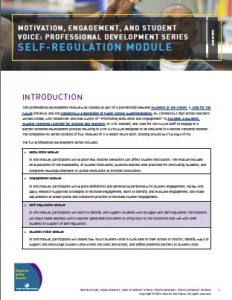
The completed PD series consists of four modules of 3-4 lesson hours each, totaling around two full days of PD. Jobs for the Future is currently working to test the Motivation, Engagement, and Student Voice Professional Development Series with educators across the country. We will continue to iterate the modules throughout this process. We welcome all comments and feedback as you explore and implement the lessons in this series. In the Engagement module, participants will learn to identify and support students who struggle with self-regulation. Participants will leave these sessions with a teacher-generated document to bring back to the classroom and use with their students in support of self-regulation.
Lesson 1: Fusing Skill and Will
Learning Outcomes: At the end of this unit, participants will be able to
- Describe the habits of a self-regulated learner
- Identify and empathize with struggling (low self-regulation) learners
- Advocate for strategies which support learners in their development of self-regulation
Essential Questions
- To what extent do my classroom practices encourage development of self-regulation strategies?
- How might I best support learners who are in need of self-regulation strategies?
Total time 1 hour 10 minutes
Lesson 2: “Misbehavior” may be Misunderstood and Mislabeled
Learning Outcomes: At the end of this unit, participants will be able to
- Identify the central ideas of self-regulation theory
- Enumerate what teachers can do to support self-regulation in students
Essential Questions
- How often do we mislabel misbehavior?
- Is self-regulation something teachers can teach?
Total time 1 hour
Lesson 3: In a Distracting World, Self-Regulation to the Rescue
Learning Outcomes: At the end of this unit, participants will be able to
- Confidently apply a menu of strategies to classroom practice that will support student’s self-regulation
- Share out their work to other groups and reflect on their process
- Bring a teacher-generated document back to their classrooms to use with their students in support of student self-regulation
Essential Questions
- What resources might help educators deepen their support for self-regulation?
- How much time, energy, and resources should we shift to new practices that support self-regulation?
Total time 1 hour 15 minutes
Download the full Self-Regulation Professional Development Module
The full professional development series also includes:
Motivation Module
In this module, participants will explore how teacher behaviors can affect student motivation. The module includes an exploration of the malleability of student motivation, explores teacher best practices for motivating students, and compares reward/punishment or praise motivation to intrinsic motivation.
Engagement Module
In this module, participants will explore definitions and personal experiences with student engagement, review and apply research-supported strategies to increase engagement, learn to identify and evaluate engagement, and make adjustments to lesson plans and classroom practice to increase student engagement.
Student Voice Module
In this module, participants will assess how much student voice is cultivated in their school or district, identify ways to support and encourage student voice within the class and school, and define potential barriers to student voice.